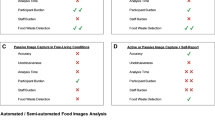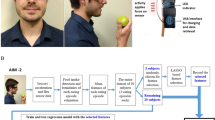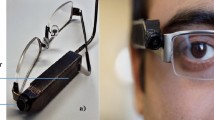Abstract
Background/Objectives:
The accuracy of dietary recalls might be enhanced by providing participants with photo images of foods they consumed during the test period.
Subjects/Methods:
We examined the feasibility of a system (Image-Diet Day) that is a user-initiated camera-equipped mobile phone that is programmed to automatically capture and transmit images to a secure website in conjunction with computer-assisted, multipass, 24-h dietary recalls in 14 participants during 2007. Participants used the device during eating periods on each of the three independent days. Image processing filters successfully eliminated underexposed, overexposed and blurry images. The captured images were accessed by the participants using the ImageViewer software while completing the 24-h dietary recall on the following day.
Results:
None of the participants reported difficulty using the ImageViewer. Images were deemed ‘helpful’ or ‘sort of helpful’ by 93% of participants. A majority (79%) of users reported having no technical problems, but 71% rated the burden of wearing the device as somewhat to very difficult, owing to issues such as limited battery life, self-consciousness about wearing the device in public and concerns about the field of view of the camera.
Conclusion:
Overall, these findings suggest that automated imaging is a promising technology to facilitate dietary recall. The challenge of managing the thousands of images generated can be met. Smaller devices with a broader field of view may aid in overcoming self-consciousness of the user with using or wearing the device.
This is a preview of subscription content, access via your institution
Access options
Subscribe to this journal
Receive 12 print issues and online access
$259.00 per year
only $21.58 per issue
Buy this article
- Purchase on Springer Link
- Instant access to full article PDF
Prices may be subject to local taxes which are calculated during checkout




Similar content being viewed by others
References
Arab L, Wesseling-Perry K, Jardack P, Henry J, Winter A (2010). Eight self-administered 24-h dietary recalls using the Internet are feasible in African Americans and Whites: the energetics study. J Am Diet Assoc 110, 857–864.
Arab L, Winter A (2010). Automated camera-phone experience with the frequency of imaging necessary to capture diet. J Am Diet Assoc 110, 1238–1241.
Baxter SD, Smith AF, Nichols MD, Guinn CH, Hardin JW (2006). Children's dietary reporting accuracy over multiple 24-h recalls varies by body mass index category. Nutr Res 26, 241–248.
Beaton GH, Milner J, Corey P, McGuire V, Cousins M, Stewart E et al. (1979). Sources of variance in 24-h dietary recall data: implications for nutrition study design and interpretation. Am J Clin Nutr 32, 2546–2559.
Boushey CJ, Kerr DA, Wright J, Lutes KD, Ebert DS, Delp EJ (2009). Use of technology in children's dietary assessment. Eur J Clin Nutr 63 (Suppl 1), S50–S57.
Bradski G (2000). The OpenCV Library. Computer security. Dr Dobb's J Softw Tools 25, 120–125.
Cole TJ, Coward WA (1992). Precision and accuracy of doubly labeled water energy expenditure by multipoint and two-point methods. Am J Physiol 263, E965–E973.
Committee on Networked Systems of Embedded Computers NRC (2010). Embedded, Everywhere. A Research Agenda for Networked Systems of Embedded Computers. National Academy Press: Washington, DC.
Janssen SM, Chessa AG, Murre JM (2006). Memory for time: how people date events. Mem Cognit 34, 138–147.
Kansal A, Kaiser W, Pottie G, Srivastava MB, Sukhatme G (2006). Virtual high-resolution for sensor networks. 4th Int Conf Embedded Netw Sensor Syst, 43–56.
Kansal A, Srivastava MB (2003). An environmental energy harvesting framework for sensor networks. Proceedings of the 2003 International Symposium on Low Power Electronics and Design. Int Symp Low Power Electron Design 481–486.
Kikunaga S, Tin T, Ishibashi G, Wang DH, Kira S (2007). The application of a handheld personal digital assistant with camera and mobile phone card (Wellnavi) to the general population in a dietary survey. J Nutr Sci Vitaminol (Tokyo) 53, 109–116.
Kovesi P (2010). MATLAB and Octave Function for Computer Vision and Image Processing. School of Computer Science and Software Engineering, The University of Western Australia, Crawley, West Australia.
Neuhouser ML, Tinker L, Shaw PA, Schoeller D, Bingham SA, Horn LV et al. (2008). Use of recovery biomarkers to calibrate nutrient consumption self-reports in the Women's Health Initiative. Am J Epidemiol 167, 1247–1259.
Raghunathan VGS, Srivastava MB (2006). Emerging techniques for long-lived wireless sensor networks. IEEE Commun Mag 44, 108–114.
Raghunathan VPC, Srivastava MB, Gupta RK (2005). Energy-aware wireless systems with adaptive power-fidelity tradeoffs (abstr). IEEE Trans Very Large Scale Integration Syst 13, 1–15.
Reddy S, Parker A, Hyman J, Burk J, Estrin D, Hansen M (2007). Image browsing, processing, and clustering for participatory sensing: lessons from a DietSense prototype. Proc Embedded Netw Sensors, 13–17.
Schatzkin A, Kipnis V (2004). Could exposure assessment problems give us wrong answers to nutrition and cancer questions? J Natl Cancer Inst 96, 1564–1565.
Schatzkin A, Kipnis V, Carroll RJ, Midthune D, Subar AF, Bingham S et al. (2003). A comparison of a food frequency questionnaire with a 24-h recall for use in an epidemiological cohort study: results from the biomarker-based Observing Protein and Energy Nutrition (OPEN) study. Int J Epidemiol 32, 1054–1062.
Schoeller DA (1988). Measurement of energy expenditure in free-living humans by using doubly labeled water. J Nutr 118, 1278–1289.
Schoeller DA (1992). Isotope dilution methods. In: Borntorp P, Brodoff BN (eds). Obesity. Lippincott Copp: Philadelphia, PA. pp 80–88.
Six BL, Schap TE, Zhu FM, Mariappan A, Bosch M, Delp EJ et al. (2010). Evidence-based development of a mobile telephone food record. J Am Diet Assoc 110, 74–79.
Smith AF (1993). Cognitive psychological issues of relevance to the validity of dietary reports. Eur J Clin Nutr 47 (Suppl 2), S6–S18.
Subar AF, Kipnis V, Troiano RP, Midthune D, Schoeller DA, Bingham S et al. (2003). Using intake biomarkers to evaluate the extent of dietary misreporting in a large sample of adults: the OPEN study. Am J Epidemiol 158, 1–13.
Sun M, Fernstrom JD, Jia W, Hackworth SA, Yao N, Li Y et al. (2010). A wearable electronic system for objective dietary assessment. J Am Diet Assoc 110, 45–47.
Swanson M (2008). Digital photography as a tool to measure school cafeteria consumption. J Sch Health 78, 432–437.
Wang DH, Kogashiwa M, Kira S (2006). Development of a new instrument for evaluating individuals’ dietary intakes. J Am Diet Assoc 106, 1588–1593.
Wang DH, Kogashiwa M, Ohta S, Kira S (2002). Validity and reliability of a dietary assessment method: the application of a digital camera with a mobile phone card attachment. J Nutr Sci Vitaminol (Tokyo) 48, 498–504.
Weiss R, Stumbo PJ, Divakaran A (2010). Automatic food documentation and volume computation using digital imaging and electronic transmission. J Am Diet Assoc 110, 42–44.
Acknowledgements
This study was supported in part by the National Institutes of Health Grant 5R01CA105048-04 and UCLA, the General Clinical Research Centers Program Grant M01-RR000865. We acknowledge the contributions by the staff of the University of California, Los Angeles, General Clinical Research Centers, in particular Joe Kim, Kellie Kutcher and Ashley Winter, during the study conduct phase. We thank Mary Catherine Cambou, Martha Sensel, PhD, and Jasmine Yaxun Chen for manuscript preparation.
Author information
Authors and Affiliations
Corresponding author
Ethics declarations
Competing interests
The authors declare no conflict of interest.
Rights and permissions
About this article
Cite this article
Arab, L., Estrin, D., Kim, D. et al. Feasibility testing of an automated image-capture method to aid dietary recall. Eur J Clin Nutr 65, 1156–1162 (2011). https://doi.org/10.1038/ejcn.2011.75
Received:
Revised:
Accepted:
Published:
Issue Date:
DOI: https://doi.org/10.1038/ejcn.2011.75
Keywords
This article is cited by
-
Automated wearable cameras for improving recall of diet and time use in Uganda: a cross-sectional feasibility study
Nutrition Journal (2023)
-
Feasibility of a SenseCam-assisted 24-h recall to reduce under-reporting of energy intake
European Journal of Clinical Nutrition (2013)
-
Survey of Sensor-Based Personal Wellness Management Systems
BioNanoScience (2013)
-
Importance of user interaction with automated dietary assessment methods
European Journal of Clinical Nutrition (2012)



